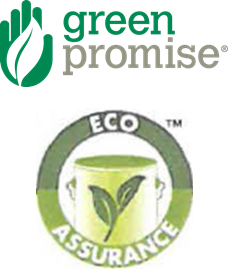If marketing claims are any indication, “green” paint is popular with consumers, but not just in the sense of emerald, mint, or avocado. Companies are advertising that their paints are emission-free, VOC-free, and without chemicals that could harm consumers, including pregnant women, babies, and people with asthma. Some brands even feature seals and certifications touting purported environmental benefits. But according to proposed FTC settlements, four paint companies – Benjamin Moore, Imperial Paints, ICP Construction, and YOLO Colorhouse – made broad-brush environmental and health claims without proper proof.
 The complaint against Benjamin Moore & Co. alleges that the company didn’t have scientific support for certain claims for its Natura line. For example, a TV ad showed painters in a nursery while a baby slept and included this voiceover: “If you want a paint with no harsh fumes; if you want a paint without harmful chemicals; if you want a paint that is safer for your family and the environment, only this can. Natura by Benjamin Moore.” The company also claimed that Natura “goes beyond zero VOC to offer zero emissions” and is “certified asthma & allergy friendly.”
The complaint against Benjamin Moore & Co. alleges that the company didn’t have scientific support for certain claims for its Natura line. For example, a TV ad showed painters in a nursery while a baby slept and included this voiceover: “If you want a paint with no harsh fumes; if you want a paint without harmful chemicals; if you want a paint that is safer for your family and the environment, only this can. Natura by Benjamin Moore.” The company also claimed that Natura “goes beyond zero VOC to offer zero emissions” and is “certified asthma & allergy friendly.”
The FTC’s action against Imperial Paints, LLC challenges representations for its Lullaby and ECOS lines. The company claimed that Lullaby – “the safest paint available” – doesn’t “contain toxic chemicals” and is “Newborn baby-safe. Pregnant mom-safe. Safe enough for kids to paint with.” Touting its ECOS line as “designed for people with multiple chemical sensitivities, asthma, allergies, and issues with everyday chemicals,” Imperial said its paints “are zero VOC and do not contain harmful solvents that off gas into the air. Safer for you, your family and the environment.”
The complaint against ICP Construction, Inc. (formerly known as California Products Corp.) challenges claims for its Muralo Paints. According to the company, Muralo BreatheSafe is “free of VOCs” and “formulated with no harmful solvents and based on a sustainable chemistry technology.” Ads claimed that BreatheSafe is “ideal for nursing homes, schools, babies’ rooms and health care facilities” and is “specified for space that is occupied during painting.”
The YOLO Colorhouse complaint challenges claims that the company’s paints have “NO VOCs, NO toxic fumes/HAPs-free, NO reproductive toxins, and NO chemical solvents.” Ads explained that “VOCs are the ‘stinky stuff’ in paint that is emitted as vapor when paint is drying. VOCs can be harmful to human health and the environment.”
You’ll want to review each complaint for the specifics, but the common thread is the FTC’s allegation that the companies didn’t have adequate substantiation to back up their claims that the VOC content and emissions of the paints are zero or at trace levels. The complaints also challenge specific claims that the products don’t give off VOCs or other chemicals during and immediately after painting. In addition, the FTC says the companies didn’t have appropriate science to prove that their paints wouldn’t emit chemicals that could materially harm consumers, including sensitive populations like pregnant women, babies, and people with asthma and allergies.
The proposed orders prohibit the companies from making unqualified emission-free and VOC-free claims, unless both the content and emissions are actually zero, or emissions are at trace levels both during painting and afterward. The orders also require the companies to have scientific evidence to support other health or environmental representations. In addition, the companies must send letters to their distributors, directing them to stop using misleading marketing materials and to sticker over deceptive claims on packaging.
For companies looking for compliance tips, the proposed settlements offer a primer.
- Substantiate the specific claims you convey to consumers. The ads in question made broad “VOC-free” and “no emissions” claims and didn’t include any qualifications or limitations. According to the FTC, consumers could reasonably understand those representations to mean that the products were “VOC-free” and “no emissions” both during and immediately after painting – claims for which the companies lacked substantiation. (What’s more, some ads featured pictures of a pregnant woman painting and a child wielding a paint roller while on his father’s shoulders, depictions the FTC says further reinforced the unqualified claims.) The message for marketers is to consider your claims in context. If a representation applies in certain circumstances but not in others, qualify your claims carefully.
 Think twice before awarding yourself a green seal. Benjamin Moore featured a “Green Promise” seal on some of its paints and Muralo labels bore an “Eco Assurance” seal. According to the FTC, consumers likely understood those seals as endorsements or certifications from an independent third party. So who bestowed the seals on the companies? The companies themselves. “Self-sealing” may be a positive attribute for envelopes, but not for advertisers that fail to disclose that seals are their own designations.
Think twice before awarding yourself a green seal. Benjamin Moore featured a “Green Promise” seal on some of its paints and Muralo labels bore an “Eco Assurance” seal. According to the FTC, consumers likely understood those seals as endorsements or certifications from an independent third party. So who bestowed the seals on the companies? The companies themselves. “Self-sealing” may be a positive attribute for envelopes, but not for advertisers that fail to disclose that seals are their own designations.
You can comments on the proposed orders by August 10, 2017. Bookmark the FTC’s Environmental Marketing page for additional resources.
